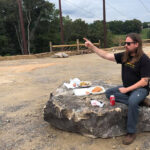Jason Sandford
Jason Sandford is a reporter, writer, blogger and photographer interested in all things Asheville.
For all you weather geeks out there: Florida newspapers have been writing about “superfog” recently, a term coined by an Asheville meteorologist. First there’s this:
It’s not just smoke and fog. It’s superfog, and it’s deadly.
Meteorologists say they finally have the word to describe the rare meteorological phenomenon that can reduce visibility on the highway to near blindness.
Superfog, a killer combination of thick smoke and dense fog that forms under certain conditions, likely was a factor behind five separate crashes on U.S. 27 near Belle Glade and South Bay that killed two people and injured 21 others in May 2006.
More recently, it was a factor behind the horrific 70-vehicle smashup on Interstate 4 in Polk County that killed five people and injured 38 in January 2008.
It forms overnight, when humidity is at its highest, as dense smoke captures air moisture and quickly condenses into ground-level superfog that flows across the landscape.
The weather anomaly is the subject of intense study because of its threat to motorists, given the state’s frequent controlled burns, high humidity and heavily traveled roads through swaths of wildlands.
Eight accidents involving superfog conditions on major Florida highways have killed 18 motorists, injured 81 and wrecked about 110 vehicles since 1996, state climate reports show.
And here’s the background on Gary L. Achtemeier, the meteorologist who coined the term in 2002:
Gary L. Achtemeier, the meteorologist who coined the word superfog in 2002, has developed a computer program that predicts it, and efforts are under way to link his program with those used by the National Weather Service.
…
Gary L. Achtemeier, a meteorologist for the U.S. Department of Agriculture in Asheville, N.C., coined the expression “superfog” in 2003. But he first became aware of the weather phenomenon in 1996.
That’s when he and other smoke researchers soaked 50 bales of hay in diesel fuel and set them on fire in Alabama to simulate a controlled burn.
As the hay burned during the evening hours, firefighters doused the blaze with water. Dense smoke developed from the smoldering embers, with a thicker layer of smoke below it. Visibility was near zero.
In 2003, Achtemeier still had superfog on his mind.
While raking and burning leaves in his backyard during a very humid evening, he noticed a plume of dense white smoke form above the pile.
The plume moved away from the smoldering leaves but retained its shape for some time.
He later re-created the fire and tested the humidity inside the plume of smoke. It registered at 100percent — or what he called superfog.
When he heard about the fatal pileup on Interstate4 in January 2008, he conducted some research and presented a paper at a gathering of meteorologists in which he says superfog is what formed the morning of the massive crash in Polk County.



















